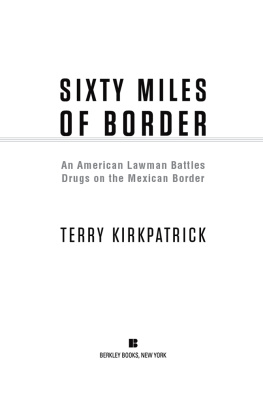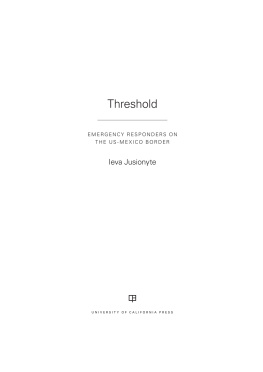Praise for A Land of Hard Edges
While U.S. migrant policy limps on bleeding feet and ignores its own hungers, a million uprooted poor huddle along our southwestern border. Ready or not, these mostly Mexican migrants join other American migrationsslaves escaping the plantations, Irish leaving a potato famine, Jews fleeing Nazis, and Okies driven out of the Dust Bowl. Retired nurse Peg Bowden joined with border angels to help, and she brings us personal stories and photos of migrants and volunteers one hopeful face at a time. Instead of proverbial loaves and fishes, now its grandmothers handing out burritos and hot coffee. Come spend a day with Bowden in the soup kitchen called el comedor. Filled with courage and compassion, this uplifting book is the best on the human side of the immigration equation that Ive yet read.
Bill Broyles, writer, educator
author of Sunshot: Peril and Wonder in the Gran Desierto
Peg is one of the most compassionate people I know, and Ive known her for 37 years since we started teaching nursing in Ashland, Oregon. Pegs experiences on the border not only reflect her dedication to helping others, but lend themselves to her thoughtful and analytic approach to social issues. A Land of Hard Edges provides a very insightful yet informative approach to understanding the issues around immigration.
Rosalie Caffrey, Ph.D. Professor Emeritus
Oregon Health & Sciences University
Peg Bowden, RN, found her retirement to the Arizona/Mexican border surprisingly disrupted by Border Patrol vehicles, helicopters and lost migrants. She chose to respond by immersing herself in the compassionate efforts of the Samaritans, capturing and presenting vividly her observations of the tragic and hopeful stories of all affected. Her on-the-ground involvement and graphic descriptions of the experiences give real life to this story.
Christian R. Amoroso, MD
In this compelling memoir of her experiences feeding and clothing migrant men, women, and children in Nogales, Sonora, Peg Bowden takes readers behind metal fences and wire barriers to view the human consequences of U.S./Mexico border policy. The stories she tells are often gut-wrenching, but she gives us hope in a world of angry political rhetoric in the resilience of the human spirit and the healing power of good works.
Bruce J. Dinges, Ph.D., editor of The Journal of Arizona History
Peg Bowden breathes life into crucial border issues so often lost in polemic. She sits us down to lunch with desperate, destitute Mexicans, our neighbors. And with warmth and wit, she shows us how humanity transcends lines on a map.
Mort Rosenblum, reporter, author, educator
In a world divided by borders and marked by the violence and suffering that these same divisions create, Peg Bowdens book stands as an eloquent testimony to the power of acts of love toward the other: the alien, the destitute, and the illegal migrant. Driven by a sense of compassion toward the immigrants she attends to in the comedor on the U.S./Mexican border, Bowden documents the everyday lives of both the extraordinary volunteers and the resilient immigrants who cross her path. This is a book that articulates a profoundly urgent vision of care, healing and love in the face of a world riven by border politics. Acutely reflexive, at once poetic and political, this compelling book asks the reader to reflect on the transformative power of humanitarian activism as a way of challenging the violent status quo of contemporary border politics.
Dr. Joseph Pugliese,
Associate Professor Research Director of the Department of Media, Music, Communication and Cultural Studies,
Macquarie University, Sydney, Australia,
Author of State Violence and the Execution of Law

A LAND OF HARD EDGES
Copyright Peg Bowden 2014
All rights reserved. No part of this book may be used or reproduced by any means, graphic, electronic, or mechanical, including photocopying, recording, taping or by any information storage retrieval system without the written permission of the publisher except in the case of brief quotations embodied in critical articles and reviews.
Peer Publishing
For more information about this book and its author, email pegbowden1942@gmail.com
1505 W. St. Marys Road, #379, Tucson, Arizona, 85745
Cover design by Pete Garceau
Interior design by Catherine Leonardo
Because of the dynamic nature of the Internet, any web addresses or links contained in this book may have changed since publication and may no longer be valid. The views expressed in this work are solely those of the author and do not necessarily reflect the views of the publisher, and the publisher hereby disclaims any responsibility for them.
Author's note: This is a work of nonfiction. Some names of the people in this book have been changed to protect the privacy of the individuals.
This edition was prepared by The Editorial Department
7650 E. Broadway, #308, Tucson, Arizona 85710
www.editorialdepartment.com
For Lester, Cheyenne and Sage
For I was hungry and you gave me food, I was thirsty and you gave me drink, I was a stranger and you welcomed me.
Matthew 25:35
When your family has been killed, there is no place to cry.
Csar, a migrant from Guatemala, September, 2012
Table of Contents
Foreword
Foreword
PAUL THEROUX
Sometimes the strangest things happen near home; and these can be the most enlightening and transformative. People go to Africa or Asia and return shocked or surprised by what theyve seenremarking on the poor, the dispossessed, the hopeless, the luckless, the victims of a pitiless system. But you dont have to travel far to observe highly colored exoticism, or dramatic difference, or extreme injustice, or even to witness the plight of the poor or dispossessed. That is one of the messages of Peg Bowdens marvelous book. Another is that there is hope.
There are two towns called Nogales, divided by an international border, and emphasized by a big fence. A simple painted sign on a wooden boardTo Mexicois propped near the door in that fence. This enormous barrier is monumental, a multimillion-dollar symbol in steel that depicts our national obsession with threat and contagion.
In a lifetime of crossing borders I find this border fence the oddest frontier I have ever seen. The frivolity of it is the price our country is paying for its delusions. When I beheld it, looming forty feet over me as I stood on a main street in Arizona beside my parked car, I looked for an entryway. And of course there it was, just where Morley Avenue endedpast J.C. Penneys and Korys Clothinga turnstile that gave Arizona access to Mexico, just ten steps from one country to the other, a door in the wall, the foreign country at the end of a hot sunlit street.
The wallrepresenting our frontieris made of enormous two-story high steel rectangles that had been recycled from plates that had served as a runway in the desert for Operation Desert Storm. Welded together these plates run as far as the eye can see along the perimeter of this part of Arizona, the big rusty bulwark of a fenced-off republic. (I first saw it in 2012. It has since been made higher and stronger and impenetrable.)
I walked through the narrow doorno line, no other formalitiesinto the state of Sonora, in the Estados Unidos Mexicanos. I was instantly, unmistakably in a foreign land, on bumpier roads, among vaguely distressed buildings and some boarded-up shop fronts, and the mingled aromas of bakeries and taco stands and risen dust.
Next page










